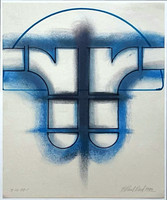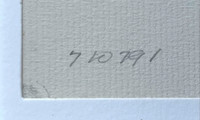
An Educated Collector is Our Best Client
In business for nearly two decades, we are a well established, popular contemporary art boutique specializing in expertly chosen, blue chip prints, multiples, uniques, books, ephemera and merchandise at different price points, with a focus on the secondary market. Please click on the "Contact Us" button at the bottom of this page for questions about any work, pricing and/or to arrange to visit our showroom/gallery - located in between Manhattan's Flatiron and Chelsea Flower Districts.
Description
Paul Allen Reed
Untitled #31, 1982
Oil pastel on paper
Pencil signed dated and annotated "7 10 79 1" by Paul Reed on the lower front
Frame included
Pencil signed dated and annotated "7 10 79 1" by renowned Washington Color School artist Paul Reed on the lower front
This work is elegantly floated and framed in a white wood museum quality frame with UV plexiglass
Measurements:
Frame:
18 x 16 x 1.5 inches
Artwork:
11 x 9 inches
About Paul Reed:
Paul Reed was born in Washington, DC in 1919 and attended McKinley High School, where fellow artists Gene Davis and Howard Mehring were also once students. Reed moved to San Diego for college, but soon returned to DC to accept a job at The Times-Herald in 1937 working in the graphics department masking out half-tones in advertisements. At the same time, he took art courses at the Corcoran School of Art during the day. Graphic design jobs would then take Reed to Atlanta and New York before Reed established himself permanently in DC in 1952. Reed worked as a freelance graphic designer throughout the 1950s so he could have some flexibility in his schedule, regularly visiting museums and galleries with Gene Davis and painting in the mornings and evenings.
Paul Reed had his first solo exhibition at the Adams-Morgan Gallery in Washington, DC in January 1963. The stained canvases were characterized by a centralized image, often with a centrifugal motion within the jig-saw shapes. Reed had a solo exhibition at the East Hampton Gallery in New York in November of the same year. Many of the paintings exhibited in New York had a centrifugal force heightened by an accompanying small satellite painting that hung in close proximity to the main painting as if it had spun out from the central image. The suggestion of a diagonal orientation through a corner of canvas left untouched foretell the Disk paintings of 1965 where two colors corners set off a diagonal band in the center of the painting. 1964 brought solo exhibitions in DC at Jefferson Place Gallery in January and in New York at East Hampton Gallery in August. Further exhibitions were held in New York at East Hampton Gallery in 1966, the Bertha Schaefer Gallery in 1967 and 1971, and in DC at the Pyramid Gallery in 1971 and 1973.
From 1966 to 1971, Paul Reed systematically increased the complexity of his color relationships within the constraints of the canvas shape. Reed first experimented with overlapping stripes of color in his 1965 Upstart series. Intrigued by the secondary colors that resulted from the overlapping he explored the “plaid” effect of grids in the series Interchange, Inside Out, and Coherence of 1966. In 1967 Reed began to work in shaped canvases where he added an additional side to his canvas shape each time he felt he had exhausted the color possibilities with the previous form. With each new shape, Reed applied color lessons learned from the prior series then expanded on them. Looking at the series Emerging (four sides), Topeka (five sides), Hackensack (six sides), and Zig-Fields (seven sides) from 1967 one sees how Reed used increasingly complex forms to master intricate color challenges.
Recognition for Paul Reed as an early member of the Washington Color School came with his inclusion in Gerald Nordland’s exhibition Washington Color Painters at the Washington Gallery of Modern Art in 1965. The exhibition traveled across the country to the University of Texas Art Galleries, Austin, TX (now the Blanton Art Museum); Art Gallery, University of California, Santa Barbara, CA; Rose Art Galleries, Brandeis University, Waltham, MA; and the Walker Art Center, Minneapolis, MN. The following year Reed was included in The Hard-Edge Trend at the National Collection of the Fine Arts (now the Smithsonian American Art Museum).
Recently Paul Reed was included in the Corcoran Gallery of Art exhibition Washington Color and Light in 2011. The same year Reed had solo exhibitions at the Workhouse Art Center in Lorton, Virginia titled Ultraviolet to Infrared: Paul Reed-50 Years and at Georgetown University, Evolution Through Color: The Art of Paul Reed, which featured paintings, sculptures, studies, and prints. The Phillips Collection hung a gallery of the artist’s paintings in their collection as a memorial in 2015. The University of Maryland University College (UMUC) held an exhibition of Reed’s work in 2018. The Oklahoma City Museum of Art purchased the Washington Gallery of Modern Art’s entire collection in 1968. They have continued to acquire Reed’s work and now have a significant holding of his work across five decades. The OKCMOA is currently organizing an exhibition of Paul Reed’s work.
Paul Reed’s work is in dozens of museums across the country, including the National Gallery of Art, the Phillips Collection, the Corcoran Gallery of Art, the Hirshhorn Museum, and Sculpture Garden and the Smithsonian Museum of American Art, all in DC; the Museum of Fine Arts, Boston; the Art Institute of Chicago; the Detroit Institute of Art; the Walker Art Center, Minneapolis; the Dallas Museum of Art; Greenville County Museum of Art, South Carolina; the High Museum of Art, Atlanta; the Oklahoma City Museum of Art; the Phoenix Art Museum; the San Francisco Museum of Modern Art; and the Wadsworth Atheneum, Hartford.













